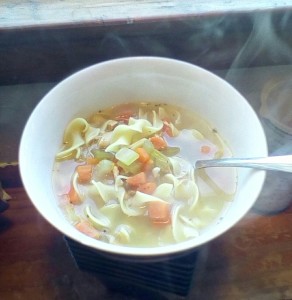When I decided to break into the world of pressure canning, I was very nervous about doing so. After canning my salsas, jams and fruits for years, I just couldn’t ignore the appeal of having other kinds of home-canned foods on the shelf, ready to eat. So after much research, I took the plunge and bought a large pressure canner and taught myself how to use it properly. The thing with low-acid foods is that you absolutely must, 100% stick to a tried and true, approved recipe for food safety purposes. That’s the scary part of pressure canning- not the pressure in the pot and danger of explosion, but the fact that if that jar of soup has not been properly prepared, it can be harboring deadly botulism.
But it was totally worth realizing that fear and taking the plunge. It has been so wonderful having all my homemade stocks on the shelf in the pantry. I go through a lot of chicken and turkey broth, which are interchangeable, but I also have ham broth and beef broth on hand as well. It’s SO much better for my family to have my homemade, nutrient rich bone broths on hand vs. the store bought chemical versions. Now, to be fair, these can certainly be frozen, and I did that just yesterday when I had a vat of turkey stock and not enough time to put the pressure canner to use. But then you have to plan ahead and thaw said stock before using it. With shelf-stable jars, they are right there at the ready whenever I need them.
Last year sometime I had purchased some pricey organic whole chickens, and decided I had better make stock from the broth, and then took it a step further and decided this would be the time that I try making my own home-canned chicken soup. Soup is one of my favorite foods, I could eat it every day for lunch and be very happy, so having my own on the shelf was very appealing. I’d made bean soup already, but as I canned that in quart jars, it’s not conducive to heating up for a quick lunch. (Though, it was excellent in the cold winter to pull two quarts off the shelf and have dinner made for the family.)
The trick when canning soups (and any pressure canning) is that fat is the enemy. Fat harbors air and botulinum spores, and that’s what we need to eliminate as much as possible with home canning. So I started with my homemade stock, which I let cool so I could skim the fat off the top. Then it was a simple matter of adding vegetables and already cooked chicken to the stock, along with some salt and dried herbs. No starch should be added to home-canned soups. No noodles, no rice, no thickeners, and very light on potatoes if using them. This was a no-frills basic chicken and vegetable soup. According to the National Center For Home Preservation, when canning homemade soup, first you fill your jar halfway with soup solids, and then the rest of the way with the liquid. This ensures that your jar will be able to expel all the air inside during the canning process.
By the way, that National Center For Home Preservation? Absolutely the perfect resource for home canning and safety. I took their self-study course and came away feeling so much more confident with my canning abilities. Plus I got to print out a groovy certificate of completion. Any recipe on their website you can feel completely secure about using as long as you follow the directions to a tee.
Anyway, I made my chicken soup, and while I’ve enjoyed it here and there, it finally proved it’s value this last week as three of the four of us brought a lovely cold home from our weekend away. It was pure pleasure to pull a few jars of chicken soup off the shelf, add a handful of noodles (and extra garlic for antiviral properties) and have lunch ready with little effort on my part. Which was important because I had no effort to give. No one had to run to the store to pick up a can or two of soup- though I do confess considering for just a moment my favorite restaurant for an amazing bowl of Pho. It was just so convenient, and so very delicious as well. Even my soup hater gobbled it up, aware that the nourishment in that bowl was going to do him a world of good.
For my recipe, I followed the recipe in my Ball Complete Book of Home Preserving, which is my Bible when it comes to canning. It lines up with the soup guidelines at the NCFHP, and is my number one recommendation for anyone wanting to get into home canning.
We’re finally feeling better here, which is perfect as spring arrived over the weekend while I slept, and my garden dreams for this new season are about to come to fruition. I also have several recipes to share now that I’m back to the land of the living, but I just had to share how wonderful having the home-canned soup on hand was.
